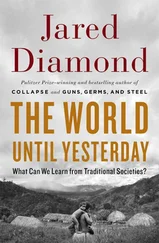Jared Diamond - Guns, Germs & Steel
Здесь есть возможность читать онлайн «Jared Diamond - Guns, Germs & Steel» весь текст электронной книги совершенно бесплатно (целиком полную версию без сокращений). В некоторых случаях можно слушать аудио, скачать через торрент в формате fb2 и присутствует краткое содержание. Жанр: 105. Описание произведения, (предисловие) а так же отзывы посетителей доступны на портале библиотеки ЛибКат.
- Название:Guns, Germs & Steel
- Автор:
- Жанр:
- Год:неизвестен
- ISBN:нет данных
- Рейтинг книги:5 / 5. Голосов: 1
-
Избранное:Добавить в избранное
- Отзывы:
-
Ваша оценка:
- 100
- 1
- 2
- 3
- 4
- 5
Guns, Germs & Steel: краткое содержание, описание и аннотация
Предлагаем к чтению аннотацию, описание, краткое содержание или предисловие (зависит от того, что написал сам автор книги «Guns, Germs & Steel»). Если вы не нашли необходимую информацию о книге — напишите в комментариях, мы постараемся отыскать её.
Guns, Germs & Steel — читать онлайн бесплатно полную книгу (весь текст) целиком
Ниже представлен текст книги, разбитый по страницам. Система сохранения места последней прочитанной страницы, позволяет с удобством читать онлайн бесплатно книгу «Guns, Germs & Steel», без необходимости каждый раз заново искать на чём Вы остановились. Поставьте закладку, и сможете в любой момент перейти на страницу, на которой закончили чтение.
Интервал:
Закладка:
130 • GUNS, GERMS, ANDsteel
protective nets and greenhouses were we finally able to defeat the thrushes, and to redesign strawberries and raspberries according to our own standards.
we've thus seen that the difference between gigantic supermarket strawberries and tiny wild ones is just one example of the various features distinguishing cultivated plants from their wild ancestors. Those differences arose initially from natural variation among the wild plants themselves. Some of it, such as the variation in berry size or in nut bitterness, would have been readily noticed by ancient farmers. Other variation, such as that in seed dispersal mechanisms or seed dormancy, would have gone unrecognized by humans before the rise of modern botany. But whether or not the selection of wild edible plants by ancient hikers relied on conscious or unconscious criteria, the resulting evolution of wild plants into crops was at first an unconscious process. It followed inevitably from our selecting among wild plant individuals, and from competition among plant individuals in gardens favoring individuals different from those favored in the wild.
That's why Darwin, in his great book On the Origin of Species, didn't start with an account of natural selection. His first chapter is instead a lengthy account of how our domesticated plants and animals arose through artificial selection by humans. Rather than discussing the Galapagos Island birds that we usually associate with him, Darwin began by discussing—how farmers develop varieties of gooseberries! He wrote, "I have seen great surprise expressed in horticultural works at the wonderful skill of gardeners, in having produced such splendid results from such poor materials; but the art has been simple, and as far as the final result is concerned, has been followed almost unconsciously. It has consisted in always cultivating the best-known variety, sowing its seeds, and, when a slightly better variety chanced to appear, selecting it, and so onwards." Those principles of crop development by artificial selection still serve as our most understandable model of the origin of species by natural selection.
CHAPTER 8
apples or indians
WE HAVE JUST SEEN HOW PEOPLES OF SOME REGIONS began to cultivate wild plant species, a step with momentous unforeseen consequences for their lifestyle and their descendants' place in history. Let us now return to our questions: Why did agriculture never arise independently in some fertile and highly suitable areas, such as California, Europe, temperate Australia, and subequatorial Africa? Why, among the areas where agriculture did arise independently, did it develop much earlier in some than in others?
Two contrasting explanations suggest themselves: problems with the local people, or problems with the locally available wild plants. On the one hand, perhaps almost any well-watered temperate or tropical area of the globe offers enough species of wild plants suitable for domestication. In that case, the explanation for agriculture's failure to develop in some of those areas would lie with cultural characteristics of their peoples. On the other hand, perhaps at least some humans in any large area of the globe would have been receptive to the experimentation that led to domestication. Only the lack of suitable wild plants might then explain why food production did not evolve in some areas.
As we shall see in the next chapter, the corresponding problem for oniestication of big wild mammals proves easier to solve, because there
I 3 2 • GUNS, GERMS, AND STEEL
are many fewer species of them than of plants. The world holds only about 148 species of large wild mammalian terrestrial herbivores or omnivores, the large mammals that could be considered candidates for domestication. Only a modest number of factors determines whether a mammal is suitable for domestication. It's thus straightforward to review a region's big mammals and to test whether the lack of mammal domestication in some regions was due to the unavailability of suitable wild species, rather than to local peoples.
That approach would be much more difficult to apply to plants because of the sheer number—200,000—of species of wild flowering plants, the plants that dominate vegetation on the land and that have furnished almost all of our crops. We can't possibly hope to examine all the wild plant species of even a circumscribed area like California, and to assess how many of them would have been domesticable. But we shall now see how to get around that problem.
When one hears that there are so many species of flowering plants, one's first reaction might be as follows: surely, with all those wild plant species on Earth, any area with a sufficiently benign climate must have had more than enough species to provide plenty of candidates for crop development.
But then reflect that the vast majority of wild plants are unsuitable for obvious reasons: they are woody, they produce no edible fruit, and their leaves and roots are also inedible. Of the 200,000 wild plant species, only a few thousand are eaten by humans, and just a few hundred of these have been more or less domesticated. Even of these several hundred crops, most provide minor supplements to our diet and would not by themselves have sufficed to support the rise of civilizations. A mere dozen species account for over 80 percent of the modern world's annual tonnage of all crops. Those dozen blockbusters are the cereals wheat, corn, rice, barley, and sorghum; the pulse soybean; the roots or tubers potato, manioc, and sweet potato; the sugar sources sugarcane and sugar beet; and the fruit banana. Cereal crops alone now account for more than half of the calories consumed by the world's human populations. With so few major crops in the world, all of them domesticated thousands of years ago, it's less surprising that many areas of the world had no wild native plants at all of outstanding potential. Our failure to domesticate even a single major new food
APPLES OR INDIANS • 133
plant in modern times suggests that ancient peoples really may have explored virtually all useful wild plants and domesticated all the ones worth domesticating.
Yet some of the world's failures to domesticate wild plants remain hard to explain. The most flagrant cases concern plants that were domesticated in one area but not in another. We can thus be sure that it was indeed possible to develop the wild plant into a useful crop, and we have to ask why that wild species was not domesticated in certain areas.
A typical puzzling example comes from Africa. The important cereal sorghum was domesticated in Africa's Sahel zone, just south of the Sahara. It also occurs as a wild plant as far south as southern Africa, yet neither it nor any other plant was cultivated in southern Africa until the arrival of the whole crop package that Bantu farmers brought from Africa north of the equator 2,000 years ago. Why did the native peoples of southern Africa not domesticate sorghum for themselves?
Equally puzzling is the failure of people to domesticate flax in its wild range in western Europe and North Africa, or einkorn wheat in its wild range in the southern Balkans. Since these two plants were among the first eight crops of the Fertile Crescent, they were presumably among the most readily domesticated of all wild plants. They were adopted for cultivation in those areas of their wild range outside the Fertile Crescent as soon as they arrived with the whole package of food production from the Fertile Crescent. Why, then, had peoples of those outlying areas not already begun to grow them of their own accord?
Similarly, the four earliest domesticated fruits of the Fertile Crescent all had wild ranges stretching far beyond the eastern Mediterranean, where they appear to have been first domesticated: the olive, grape, and fig occurred west to Italy and Spain and Northwest Africa, while the date palm extended to all of North Africa and Arabia. These four were evidently among the easiest to domesticate of all wild fruits. Why did peoples outside the Fertile Crescent fail to domesticate them, and begin to grow them only when they had already been domesticated in the eastern Mediterranean and arrived thence as crops?
Other striking examples involve wild species that were not domesticated in areas where food production never arose spontaneously, even though those wild species had close relatives domesticated elsewhere. For example, the olive Olea europea was domesticated in the eastern Mediterranean. There are about 40 other species of olives in tropical and southern
Интервал:
Закладка:
Похожие книги на «Guns, Germs & Steel»
Представляем Вашему вниманию похожие книги на «Guns, Germs & Steel» списком для выбора. Мы отобрали схожую по названию и смыслу литературу в надежде предоставить читателям больше вариантов отыскать новые, интересные, ещё непрочитанные произведения.
Обсуждение, отзывы о книге «Guns, Germs & Steel» и просто собственные мнения читателей. Оставьте ваши комментарии, напишите, что Вы думаете о произведении, его смысле или главных героях. Укажите что конкретно понравилось, а что нет, и почему Вы так считаете.










